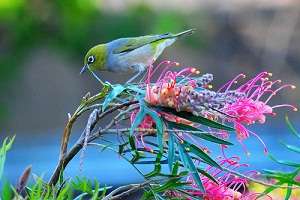Digestive enzyme key to nectarivores' sweet tooth

A study of nectar-feeding birds found in Western Australia has uncovered a significant correlation between their digestive physiology and foraging preferences.
The findings of the paper provide an answer to something which has long intrigued researchers—what is behind the pattern of sugar concentration preferences of nectar-feeding birds?
Paper co-author Kathryn Napier, from the Murdoch University School of Animal and Veterinary Sciences, carried out the research as part of her PhD.
She says the authors wanted to investigate the potential physiological mechanisms driving nectarivores – birds which feed on nectar – to select nectar preference at certain sugar concentrations.
"We assessed sugar preferences and intestinal sucrase activity of Australian specialist and generalist nectarivores for comparison with published data from other nectarivorous bird species and compared laboratory data with foraging records from the wild," Ms Napier says.
While it has previously been suggested that sugar concentration preferences may be attributed to varying levels of sucrase activity – the intestinal enzyme responsible for breaking down sucrose – this study is the first to demonstrate it as the key digestive constraint contributing to diet selectivity.
"Our study demonstrates that the digestive physiology of these birds is more closely correlated to their diet preferences, rather than a simplistic differentiation in diet preferences between specialist and generalist nectarivores," Ms Napier says.
To determine sugar preferences, three species of birds took part in a trial where birds were simultaneously presented with pairs of feeders containing sucrose and hexose at seven paired concentrations in a random order.
In conjunction with intestine examinations, reading existing literature, and trials, the paper found birds with the lowest sucrase activity showed a preference for hexose in more concentration.
Birds with the greatest sucrase activity showed no hexose preference or only hexose preference on the most dilute diets.
Ms Napier says the findings pointed to a need for a multifaceted approach to research in the field, as well as the difficulty of using simplistic classifications like 'specialist' and 'generalist' nectarivores to classify Australian nectar-feeding birds.
The specialist nectarivore lineage of lorikeet, for example, demonstrated a significant preference for hexose solutions at a wide range of concentrations—differing from other specialist nectarivores, placing it closer to generalist nectarivores.
"Rainbow lorikeets also preferentially foraged on hexose nectars in the wild, while the honeyeater species studied [both specialist and generalist nectarivores] avoided hexose nectars," Ms Napier says.
More information: www.ncbi.nlm.nih.gov/pubmed/23995481
Provided by Science Network WA


















